An Edited Excerpt from "Your Developing Baby" Chapter 13
Ultrasound lets the doctor check on some aspects of the baby's health, especially those that involve the baby's structure and size. There are other tests that can be used together with ultrasound to get extra information about the baby.
Tests for the Baby's Health: Amniocentesis and Others
Ultrasound lets the doctor check on some aspects of the baby's health, especially those that involve the baby's structure and size. There are other tests that can be used together with ultrasound to get extra information about the baby. Some of these tests involve the pregnancy support systems that we discussed in the previous chapter: amniocentesis, which removes amniotic fluid for testing; chorionic villus sampling (CVS), which obtains small pieces of the placenta for evaluation; and umbilical blood sampling, which involves removing a sample of the
blood to be analyzed. The most frequently used of these procedures is amniocentesis. These tests are performed only if there are certain indications that the baby might be at risk and that the test can provide the doctor with information to help care for the mother and baby. Such indications include the age of the mother (thirty-five or older), a family history of or a previous child with hereditary disease, or an ultrasound finding that raises concern for the health of the baby.
Amniocentesis
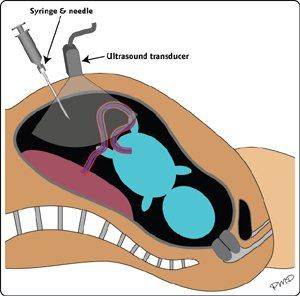
Stay away from that baby! Under the watchful "eye" of the ultrasound image (the grey area in this diagram), the doctor makes sure that the amniocentesis needle stays away from the baby and the umbilical cord.
Amniocentesis in a sixteen-week pregnancy. Ultrasound monitoring helps the doctor make sure the needle avoids the baby and umbilical cord.

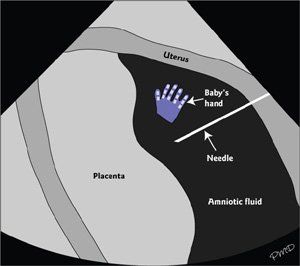
Amniocentesis is the removal of a sample of amniotic fluid from the gestational sac through a thin needle. This test can be used to check for hereditary or genetic diseases--such as Down syndrome, an abnormality of the baby's chromosomes--that may not show up on
alone. It also has other uses in special circumstances, such as to check for infection in the amniotic fluid that might require treatment, or to determine whether the baby's lungs are ready to work on their own to breathe air.
You might wonder how the fluid that the baby is floating in can give us information about the baby's chromosomes. The answer lies in the behavior of cells. Every time you touch or brush your skin against something, some of your skin cells fall off. These cells are microscopic, of course, so you don't see them. The same thing happens to the baby. Even though the baby is floating in amniotic fluid, skin cells are always falling off and floating around in the fluid. By removing a small amount of amniotic fluid, we get a sample of the baby's cells and put these cells through a genetic analysis to find out about the baby's chromosomal and genetic makeup.
Amniocentesis is not a new procedure; it has been used for about fifty years, well before the common use of ultrasound. But today, thanks to ultrasound, amniocentesis is safer than ever. As you can see in the diagrams and image above, a needle is inserted into the gestational sac and a syringe is used to withdraw a small amount of fluid--about four teaspoons for a genetic diagnosis, and considerably less for other testing. Because the baby is moving around in that same fluid, continuous ultrasound guidance is used to make sure that the needle does not poke the baby. If the baby approaches the needle, this will be seen on the ultrasound image and the doctor can move the needle away from the baby.
During this relatively painless procedure, about one-half to one and a half inches of the needle extends into the amniotic fluid, which is then drawn up into a syringe. When the right amount of fluid has been withdrawn, the needle is removed, and the uterine wall closes up tightly over the tiny hole so that there is no bleeding or leakage of fluid.
Chorionic Villus Sampling
Chorionic villus sampling, commonly referred to as CVS, is another way to test for certain hereditary or genetic abnormalities when there are indications that the baby might be at risk. It is important to realize that even if a doctor recommends a CVS or amniocentesis, in the vast majority of cases the results of these tests turn out to be normal and the baby is healthy.
When there are indications for an amniocentesis or CVS for genetic testing, how do the doctor and mother choose between these two tests? Amniocentesis, a quicker and simpler procedure than CVS, is chosen more often than CVS. But CVS provides answers at an earlier point in pregnancy than amniocentesis. CVS is usually done between ten and twelve weeks' gestation, and the results are available in just a few days, while amniocentesis is commonly done at fifteen to eighteen weeks' gestation and the results come back one to two weeks later. So CVS is often chosen if the mother or doctor doesn't want to wait until after fifteen weeks to get the answer.
A Genetic Blueprint
As we learned in earlier chapters, the placenta is made up of cells that come from both
. The chorion is the part of the placenta that comes from the baby, so its cells have the same genetic makeup as the baby. By extracting some cells--called chorionic villi (plural of villus)--from the placenta, growing them in the laboratory, and looking at their chromosomes, we can see a genetic blueprint of the baby and determine whether there are genetic abnormalities. There are two ways to remove the chorionic villus cells, shown in the pair of diagrams below.
Transabdominal CVS. This method involves inserting a needle through the mother's abdomen into the placenta, guided by ultrasound. Once the needle is in the proper location, tiny pieces of placenta are removed by the suction of a syringe attached to the needle.
Transcervical CVS. This method uses a soft catheter inserted into the vagina and through the cervix, and then threaded--using ultrasound guidance--along the outside of the gestational sac until the tip is inserted into the placenta. Then small bits of placenta are drawn out into the syringe.
Chorionic villus sampling. The shaded areas below the ultrasound transducer on the diagrams show the region seen in the ultrasound image. The transabdominal approach (left diagram) uses a needle inserted through the mother's abdomen and the wall of the uterus into the placenta. The transcervical approach (right diagram) uses a flexible catheter inserted through the mother's vagina and cervix, with the tip advanced into the placenta.
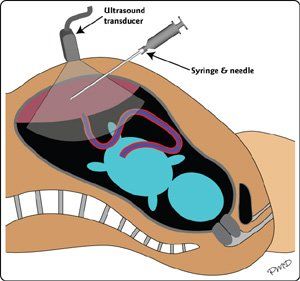
Following either CVS procedure, a technician takes the contents of the syringe and uses a special technique to separate the baby's cells (chorionic villi) from the mother's cells (decidua). The baby's cells are then genetically analyzed.
The decision about whether to use the transabdominal or transcervical technique depends, in part, on the location of the placenta. If the placenta is in the front of the uterus, a transabdominal CVS is generally best; if it is toward the mother's back, the transcervical technique is often used. Whichever technique is chosen, the test is relatively painless for the mother and the needle or catheter does not enter the gestational sac or touch the baby.
Chorionic Villus Sampling in Real Life
The next ultrasound images and accompanying diagrams show you what the doctor inserting the needle or catheter sees on the ultrasound screen when performing chorionic villus sampling. The video and diagram below show a transabdominal CVS. You can see the needle as a straight white line ending up in the placenta. Ultrasound guidance makes sure that the needle is in the placenta and does not enter into the amniotic fluid or come into contact with the baby.
Transabdominal chorionic villus sampling in a twelve-week pregnancy.
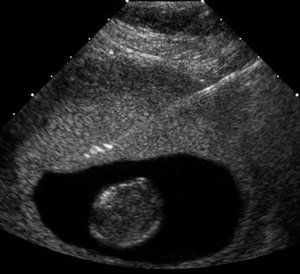

The image and diagram below the insertion of a catheter--seen as a curved white line--for a transcervical CVS, again using ultrasound guidance to make sure that the procedure is safe and successful.
Transcervical chorionic villus sampling in a twelve-week pregnancy.
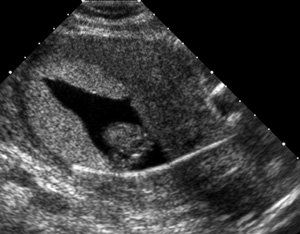
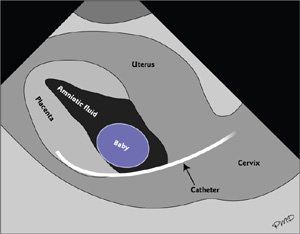
Umbilical Blood Sampling
Doctors often use blood tests to check on the health of a patient. An obstetrician caring for a pregnant woman will often do blood tests on the mother, such as a test in early pregnancy to confirm that she is in fact pregnant, or a test for blood sugar levels to check for diabetes. Occasionally, the obstetrician needs to examine the baby's blood to make sure that the baby is healthy. This might be done to check whether the baby is anemic or to test for the presence of enzymes in the baby's blood that might indicate a health concern.
When the doctor needs to do a blood test on the baby, blood is obtained from the umbilical vein--which is located inside the umbilical cord and transports blood from the placenta to the baby. Using ultrasound guidance, a tiny needle is passed through the mother's abdomen into the point at which the umbilical cord attaches to the placenta. This is a good spot because the cord is anchored there and does not move. A few drops of blood are pulled into a syringe attached to the needle. There is no pain to the baby and very little to the mother, since the placenta and umbilical cord do not have nerves to feel pain.
In rare circumstances, a similar procedure can be done to treat the baby when a problem is present. For example, if the baby is anemic the doctor can give the baby a transfusion by injecting blood into the umbilical vein. In other cases, medication can be injected.
The two drawings below show the positions of the ultrasound transducer, needle, syringe, and umbilical cord when umbilical blood sampling is done. The path of the needle depends on where the placenta is located and where the umbilical cord attaches to it. If the placenta is in the front of the uterus (left diagram), the needle goes through the placenta into the umbilical vein without going through the amniotic fluid. If the placenta is in the back, toward the mother's spine (right diagram), the needle must go through the amniotic fluid to get to the umbilical vein. During these procedures, the doctor uses ultrasound to guide the needle into the proper location and to avoid any contact with the baby. Whether the placenta is in the front or the back, the needle enters the umbilical cord where it is anchored to the placenta.
Umbilical blood sampling
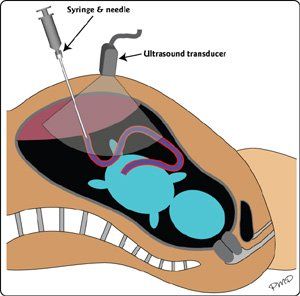
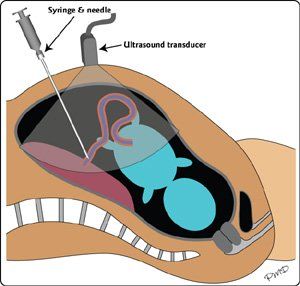
The remaining images and diagrams show the umbilical blood sampling procedure in real life, with the placenta in different locations.
Umbilical blood sampling when the placenta is in the front of the uterus.
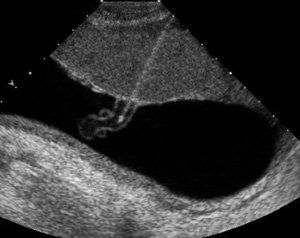
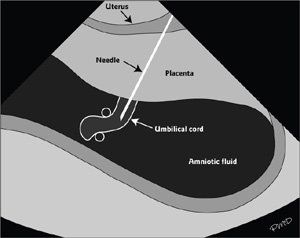
Umbilical blood sampling when the placenta is in the back of the uterus.
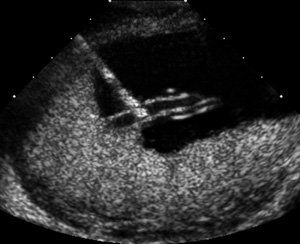
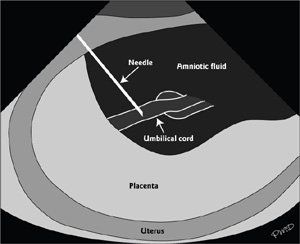
References:
From
YourDevelopingBaby.com
S1E4: Dr. Kristina Adams-Waldorf: Pandemics, pathogens and perseverance
July 16th 2020This episode of Pap Talk by Contemporary OB/GYN features an interview with Dr. Kristina Adams-Waldorf, Professor in the Department of Obstetrics and Gynecology and Adjunct Professor in Global Health at the University of Washington (UW) School of Medicine in Seattle.
Listen
Study shows a healthy prenatal diet could be upstream obesity prevention strategy
December 26th 2024"Our findings support the recommendation of a healthy diet based on the current guidelines (as measured by the HEI) during pregnancy, since it may reduce patterns of infant growth outside reference ranges."
Read More
Early pregnancy cannabis use high in states with recreational legalization
November 11th 2024A population-based time-series analysis California before, during and after legalization show a rising trend in women using cannabis while pregnancy especially when the state has legalized the drug.
Read More
